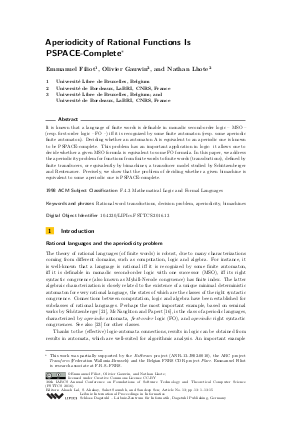Aperiodicity of Rational Functions Is PSPACE-Complete
Authors Emmanuel Filiot, Olivier Gauwin, Nathan Lhote
-
Part of:
Volume:
36th IARCS Annual Conference on Foundations of Software Technology and Theoretical Computer Science (FSTTCS 2016)
Part of: Series: Leibniz International Proceedings in Informatics (LIPIcs)
Part of: Conference: IARCS Annual Conference on Foundations of Software Technology and Theoretical Computer Science (FSTTCS) - License:
 Creative Commons Attribution 3.0 Unported license
Creative Commons Attribution 3.0 Unported license
- Publication Date: 2016-12-10
File

PDF
LIPIcs.FSTTCS.2016.13.pdf
- Filesize: 0.51 MB
- 15 pages
Document Identifiers
Subject Classification
Keywords
- Rational word transductions
- decision problem
- aperiodicity
- bimachines
Metrics
- Access Statistics
-
Total Accesses (updated on a weekly basis)
0PDF Downloads0Metadata Views
Abstract
It is known that a language of finite words is definable in monadic second-order logic - MSO - (resp. first-order logic - FO -) iff it is recognized by some finite automaton (resp. some aperiodic finite automaton). Deciding whether an automaton A is equivalent to an aperiodic one is known to be PSPACE-complete. This problem has an important application in logic: it allows one to decide whether a given MSO formula is equivalent to some FO formula. In this paper, we address the aperiodicity problem for functions from finite words to finite words (transductions), defined by finite transducers, or equivalently by bimachines, a transducer model studied by Schützenberger and Reutenauer. Precisely, we show that the problem of deciding whether a given bimachine is equivalent to some aperiodic one is PSPACE-complete.
Cite As Get BibTex
Emmanuel Filiot, Olivier Gauwin, and Nathan Lhote. Aperiodicity of Rational Functions Is PSPACE-Complete. In 36th IARCS Annual Conference on Foundations of Software Technology and Theoretical Computer Science (FSTTCS 2016). Leibniz International Proceedings in Informatics (LIPIcs), Volume 65, pp. 13:1-13:15, Schloss Dagstuhl – Leibniz-Zentrum für Informatik (2016)
https://doi.org/10.4230/LIPIcs.FSTTCS.2016.13
BibTex
@InProceedings{filiot_et_al:LIPIcs.FSTTCS.2016.13,
author = {Filiot, Emmanuel and Gauwin, Olivier and Lhote, Nathan},
title = {{Aperiodicity of Rational Functions Is PSPACE-Complete}},
booktitle = {36th IARCS Annual Conference on Foundations of Software Technology and Theoretical Computer Science (FSTTCS 2016)},
pages = {13:1--13:15},
series = {Leibniz International Proceedings in Informatics (LIPIcs)},
ISBN = {978-3-95977-027-9},
ISSN = {1868-8969},
year = {2016},
volume = {65},
editor = {Lal, Akash and Akshay, S. and Saurabh, Saket and Sen, Sandeep},
publisher = {Schloss Dagstuhl -- Leibniz-Zentrum f{\"u}r Informatik},
address = {Dagstuhl, Germany},
URL = {https://drops.dagstuhl.de/entities/document/10.4230/LIPIcs.FSTTCS.2016.13},
URN = {urn:nbn:de:0030-drops-68482},
doi = {10.4230/LIPIcs.FSTTCS.2016.13},
annote = {Keywords: Rational word transductions, decision problem, aperiodicity, bimachines}
}
Author Details
References
-
Marie-Pierre Béal, Olivier Carton, Christophe Prieur, and Jacques Sakarovitch. Squaring transducers: an efficient procedure for deciding functionality and sequentiality. Theor. Comput. Sci., 292(1):45-63, 2003.

-
Jean Berstel and Luc Boasson. Transductions and context-free languages. Ed. Teubner, pages 1-278, 1979.

- Mikołaj Bojańczyk. Transducers with origin information. In International Colloquium on Automata, Languages, and Programming (ICALP), Part II, volume 8573 of Lecture Notes in Computer Science, pages 26-37. Springer, 2014. URL: http://dx.doi.org/10.1007/978-3-662-43951-7_3.
- Olivier Carton and Luc Dartois. Aperiodic two-way transducers and fo-transductions. In EACSL Annual Conference on Computer Science Logic (CSL), volume 41 of LIPIcs, pages 160-174. Schloss Dagstuhl - Leibniz-Zentrum fuer Informatik, 2015. URL: http://dx.doi.org/10.4230/LIPIcs.CSL.2015.160.
- Sang Cho and Dung T. Huynh. Finite-automaton aperiodicity is PSPACE-complete. Theor. Comput. Sci., 88(1):99-116, 1991. URL: http://dx.doi.org/10.1016/0304-3975(91)90075-D.
- Christian Choffrut. Minimizing subsequential transducers: a survey. Theor. Comput. Sci., 292(1):131-143, 2003. URL: http://dx.doi.org/10.1016/S0304-3975(01)00219-5.
- Bruno Courcelle. Monadic second-order definable graph transductions: A survey. Theor. Comput. Sci., 126(1):53-75, 1994. URL: http://dx.doi.org/10.1016/0304-3975(94)90268-2.
-
Volker Diekert and Paul Gastin. First-order definable languages. In Logic and Automata: History and Perspectives [in Honor of Wolfgang Thomas], volume 2 of Texts in Logic and Games, pages 261-306. Amsterdam University Press, 2008.

-
Samuel Eilenberg. Automata, Languages, and Machines. Volume A. Pure and Applied Mathematics. Academic press, 1974.

- Calvin C. Elgot and Jorge E. Mezei. On relations defined by generalized finite automata. IBM Journal of Research and Development, 9(1):47-68, 1965. URL: http://dx.doi.org/10.1147/rd.91.0047.
- Joost Engelfriet and Hendrik Jan Hoogeboom. MSO definable string transductions and two-way finite-state transducers. ACM Trans. Comput. Log., 2(2):216-254, 2001. URL: http://dx.doi.org/10.1145/371316.371512.
- Emmanuel Filiot. Logic-automata connections for transformations. In Indian Conference on Logic and Its Applications (ICLA), volume 8923 of Lecture Notes in Computer Science, pages 30-57. Springer, 2015. URL: http://dx.doi.org/10.1007/978-3-662-45824-2_3.
-
Emmanuel Filiot, Olivier Gauwin, and Nathan Lhote. First-order definability of rational transductions: An algebraic approach. In Annual ACM/IEEE Symposium on Logic in Computer Science (LICS). IEEE Computer Society, 2016.

- Emmanuel Filiot, Shankara Narayanan Krishna, and Ashutosh Trivedi. First-order definable string transformations. In International Conference on Foundation of Software Technology and Theoretical Computer Science (FSTTCS), volume 29 of LIPIcs, pages 147-159. Schloss Dagstuhl - Leibniz-Zentrum fuer Informatik, 2014. URL: http://dx.doi.org/10.4230/LIPIcs.FSTTCS.2014.147.
-
John E. Hopcroft. An N log N Algorithm for Minimizing States in a Finite Automaton. Technical report, Stanford University, Stanford, CA, USA, 1971.

-
Robert McNaughton and Seymour Papert. Counter-free automata. M.I.T. Press, 1971.

- Christophe Reutenauer and Marcel-Paul Schützenberger. Minimization of rational word functions. SIAM J. Comput., 20(4):669-685, 1991. URL: http://dx.doi.org/10.1137/0220042.
- Christophe Reutenauer and Marcel-Paul Schützenberger. Variétés et fonctions rationnelles. Theor. Comput. Sci., 145(1&2):229-240, 1995. URL: http://dx.doi.org/10.1016/0304-3975(94)00180-Q.
-
Jacques Sakarovitch. Elements of Automata Theory. Cambridge University Press, 2009.

-
Marcel-Paul Schützenberger. A remark on finite transducers. Information and Control, 4(2-3):185-196, 1961.

-
Marcel-Paul Schützenberger. On finite monoids having only trivial subgroups. Information and Control, 8(2):190-194, 1965.

- Jacques Stern. Complexity of some problems from the theory of automata. Information and Control, 66(3):163-176, 1985. URL: http://dx.doi.org/10.1016/S0019-9958(85)80058-9.
-
Howard Straubing. Finite Automata, Formal Logic, and Circuit Complexity. Birkhauser Verlag, Basel, Switzerland, Switzerland, 1994.

